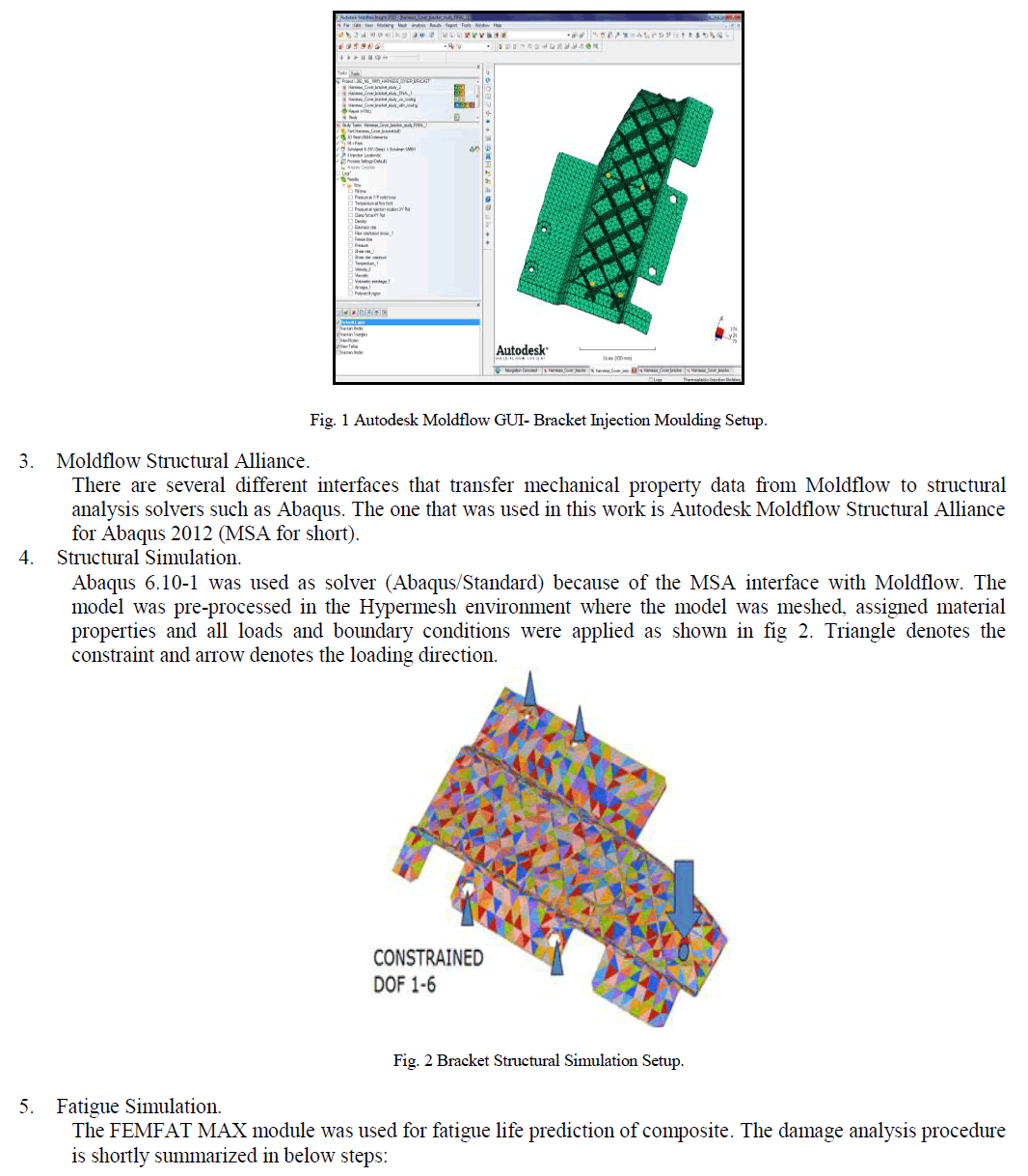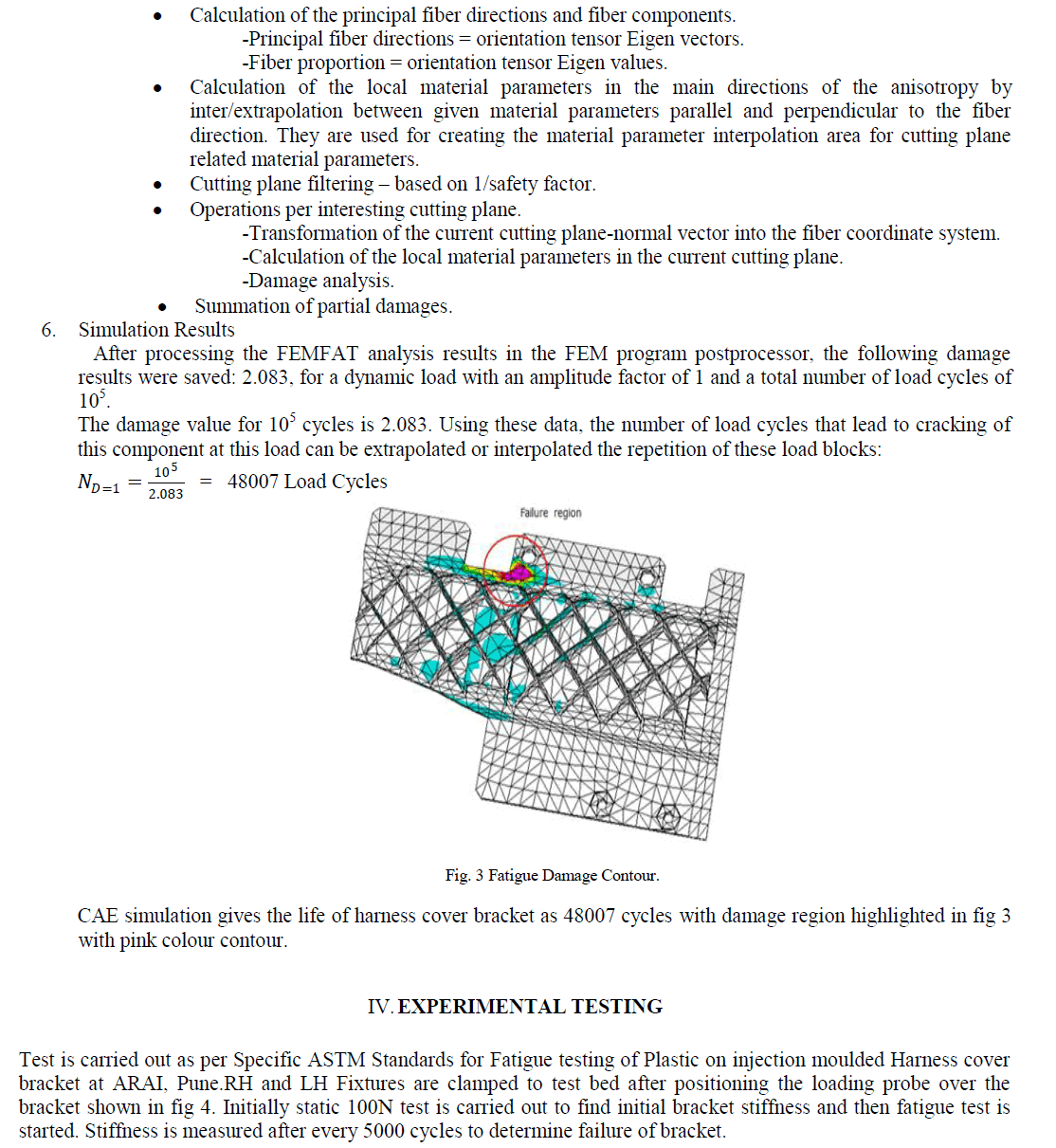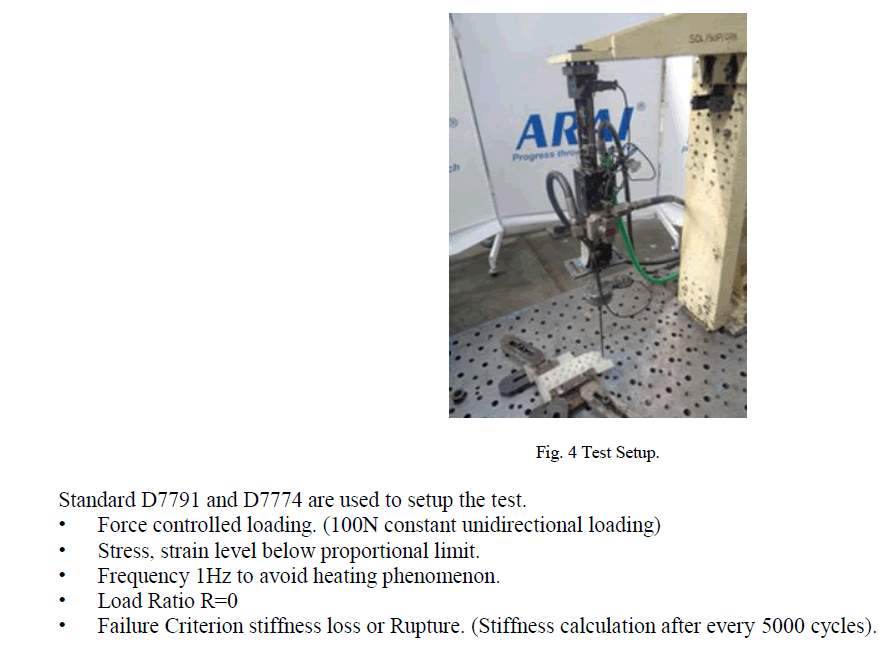ISSN ONLINE(2319-8753)PRINT(2347-6710)
ISSN ONLINE(2319-8753)PRINT(2347-6710)
Kiran Jagdale1, A. V. Bhosale2
|
| Related article at Pubmed, Scholar Google |
Visit for more related articles at International Journal of Innovative Research in Science, Engineering and Technology
Toincrease stiffness and strength of injection moulded components short glass fibres were added as filler material. The application of short fibre reinforced plastic materials has become more important over the last years, because they can be designed as per specific requirements. Short fibre-reinforced plastics provide the combination of lower weight with adequate strength. The recent trend in industry is to have the lighter product; somany structural parts are manufactured with short fibre-reinforced polymers instead of traditional metal. The design of the final product has to pass assessment of durability or reliability aspects in addition to structural strength aspects. Prediction of fatigue life for fiber reinforced composite identifies critical areas for the product development in early stage, which saves the cost of re-test and redesign. This paper is concerned with animplementation of virtual durability product development process to predict fatigue life of short fibre-reinforced materials. The multi-disciplinary process consists of aninjection moulding simulation, followed by a structural stress analysis and a fatigue calculation. This analysis method and simulation process which takes into account the fibre orientation and distribution as result from moulding simulation have been verified with component test.
Keywords |
| Short fiber reinforced composite, PA6GF15, Fatigue, Moldflow Simulation, etc. |
INTRODUCTION |
| In order to make cars lighter without compromising demands on durability, safety and comfort, new materials are constantly developed and existing ones refined. One measure that can be taken is to increase the amount of composites in the car, and only use steel when its specific properties are required. This work is concerned with modelling and analysing short fibre polymer composites, which are the result of injection moulding plastics reinforced with short glass fibres. These fall into the category short fibre composites. |
| This work concentrates on the virtual part of the durability product development for lifetime predictions of composite. It is built from short fibre-reinforced polymers, but could easily transfer to other materials. The process takes place in the concept design phase to minimize costs and should manage as few physical testing as possible. The simulation methodology consists of multi-disciplinary engineering areas, injection moulding, structural analysis and fatigue analysis. |
| The aim is to predict the life of a component of short fibre-reinforced polymers, especially short fibre-reinforced thermoplastic. The process devotes resources of an existing CAE environment, which sets limits of the simulations and confines the quality of the fatigue results. |
| The simulation of the production of the component initiates the virtual durability product development process. It is followed by a structural analysis. The fatigue analysis constitutes the main part of the process. At the end of the process the lifetime is predicted and critical locations in the design are identified. Based on the results the design could be optimized before various prototypes have to be built and physically tested. The use of the virtual durability product development process reduces the number of prototypes. |
LITERATURE REVIEW |
| Dr. Anastasios P. Vassilopoulos and Prof. Thomas Keller wrote the book named “Fatigue of Fiber-reinforced Composites”, which provide information regarding the fatigue behaviour of the examined materials and lead the reader step by step through the available methods for the modelling of the fatigue life of fiber-reinforced composite materials and the prediction of their lifetime in the presence of complex, variable amplitude stress fields. Bryan Harris wrote the book named “Engineering Composite Material”, which covers the making of composite material, elastic and strength properties of composite, fracture and toughness of composite, fatigue behaviour of composite, environmental effect on composite. |
| A. Bernasconi , P. Davoli , A. Basile , A. Filippi presented the effect of fibre orientation on the fatigue strength of a short glass fibre reinforced polyamide-6. Andrea Bernasconi presented Role of Fillers in the Fatigue Behaviour of a Short Glass Fibre Reinforced Polyamide. Fatigue tests on different types of reinforced polyamides were conducted with the aim of understanding their fatigue behaviour and the role of the different types of fillers and reinforcements on the fatigue damage mechanism. Fillers and reinforcements consisted of short glass fibres, mineral filler, glass beads and mixtures |
| Peter H. Foss presented Coupling of Flow Simulation and Structural Analysis for Glass-Filled Thermoplastics. Worked on a method where commercially available injection moulding and structural analysis software may be coupled together with appropriate material property data to improve prediction of structural performance for parts moulded from short glass fiber-filled plastics. Mehrdad Zoroufi worked on Significance of Fatigue Testing Parameters in Plastics versus Metals. He intends to address the distinctions between plastics and metals with respect to fatigue testing parameters. |
| S. Vervoort had worked on virtual durability product development process (VDPD) to predict fatigue life of short fibre-reinforced materials. The multi-disciplinary process consists of a manufacturing simulation, followed by a finite element structural analysis and a fatigue calculation. His work focused on the fatigue analysis of short fibre composites which applies finite element results, cyclic loads and fatigue material properties as inputs. The calculation is carried out using nCode Design Life. |
| C. M. Sonsino and E. Moosbrugger investigated fatigue strength behaviour of a short-glass-fibre reinforced polyamide PA66-GF35. The consideration of influencing variables like notches, fibre orientation, temperature, meanstress and spectrum loading enable the fatigue design of high loaded plastic parts in engine compartments. A design method was developed which is based on FE calculation of the maximum local stress, the appertaining stress gradient and the highly stressed material volume. |
SIMULATION METHODOLOGY |
| Simulation Methodology developed in ref 8 is referred for this work. The mechanical properties influencing parameters, fibre orientation and distribution are a result of the injection moulding simulation and have to be considered for fatigue life calculation and stress analysis. For the fiber reinforced plastics it is essential to perform the stress analysis with anisotropic material parameters. The simulation model is built in Autodesk Moldflow Insight. The injection moulding simulation requires very fine mesh, but for structural analysis usually coarse mesh is sufficient, otherwise the calculation effort is too high. But as I don’t had access to material properties mapping tool within different mesh size, injection moulding simulation mesh was used for structural analysis. By using stress analysis result file and fiber orientation tensors fatigue calculation were performed in FEMFAT. |
| Simulation carried out in below steps- |
| 1. Virtual Modelling. |
| The Harness cover bracket is identified for the study, which is made of PA6GF15 material, manufactured by 4 gate injection moulding process. The finite element model (outer shell mesh) based on an existing CAD design is created in Hypermesh. |
| 2. Moldflow Simulation. |
| For the injection moulding simulation Autodesk Moldflow Insight Basic 2012 was used. The part is meshed with tetrahedral elements in Autodesk Moldflow and Fill+Pack Analysis is performed, shown in fig 1. |
 |
 |
 |
RESULTS AND DISCUSSION |
| To interpret the quality of the fatigue calculation the result has to be correlated. Fatigue failure behaviour of composite exhibits stiffness decay with respect to number cycles of load application. During the testing stiffness is measured after every 5000 cycles to check the stiffness decay rate. The total scheme of experimentation is conducted at constant load. This phenomenon of constant bending load for yielding deflection is also known as stiffness. |
| After applying load for 60,000 cycles bracket stiffness degrade by 50%, which is being accepted as failure point for bracket.CAE simulation procedure calculates the fatigue life as 48007 cycles, damaged region highlighted in fig 3. It was found that there is 20% difference between the calculated and the tested number of cycles to failure. CAE results of fatigue life calculation are conservative and within a typical scatter band for fatigue analysis. The maximum damaged location from CAE and test is in good accordance. |
| It has been shown that it is possible to use injection moulding process simulation to establish the process induced fibre orientation, and hence predicts stiffness, strength and fatigue life of injection moulded SFC. |
CONCLUSION |
| It has been shown in this work that it is possible to use injection moulding process simulations to establish the process induced fibre orientation, and hence predicts stiffness, strength and fatigue life of injection moulded short fiber composite. By knowing the fibre orientation and thus the anisotropic material properties, analysis of Short fiber reinforced composite will become more accurate. |
| For validation of the composite fatigue life simulation process component fatigue life test is performed with an injection moulded harness cover bracket. The generated results show very good co-relation regarding to area of maximum damage.The simulation process utilizes standard software and their available interface for life prediction, which savescostly re-designs and re-tests. |
References |
|